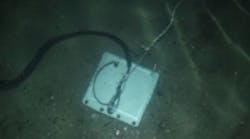Underwater vision-guided robot helps in oil spill cleanup
Researchers at William and Mary’s Virginia Institute of Marine Science (VIMS) have developed avision-guided remotely operated vehicle (ROV) that uses sound waves to locate and gauge the thickness of oil slicks caused by a spill.
MORE ARTICLES
Vision-guided robot helps make new discoveries under the ice in Antarctica
Autonomous underwater robot targets search and tracking operations
A major challenge that cleanup crews face during an offshore oil spill is determining just how much oil is involved, according to project leader and VIMS adjunct professor Paul Panetta.
“Gauging the volume of a spill, and the extent and thickness of its surface slick, are usually done by visual surveillance from planes and boats, but that can be quite difficult,” said Panetta, who is also a scientist with Applied Research Associates, Inc. “Our ROV [remotely operated vehicle] uses acoustic signals to help more easily locate and focus on the thickest part of the slick.”
The ROV is built around waterproof motorized tracks that are rated to a depth of 100 feet, have a top speed of 32 ft/min, and can pull up to 100 lbs. On top of the tracks is an aluminum platform that houses the vehiclessensors, which include four acoustic transducers to send and receive sound waves, and two video cameras that enable the human operator to steer the robot. The robot’s main electronics are in a plastic case above the waterline. The ROV is tethered to these electronics by 130 ft. of cables. A controlling computer connects to the electronics via Wi-Fi, so that the operator can operate the electronics-ROV package from the surface.
Thickness of the oil spill is determined by emittedsound waves from below the surface of the water, from the ocean floor. These waves reflect off the density boundaries between water and oil, oil and air, or oil and ice. Measuring the slight delay between the receptions of these reflected echoes allows the vehicle’s software to gauge the thickness of surface and below-ice oil slicks at very fine resolution—from slicks less than 0.5 mm thick to more substantial accumulations of up to several centimeters.
Page 1 |Page 2
About the Author

James Carroll
Former VSD Editor James Carroll joined the team 2013. Carroll covered machine vision and imaging from numerous angles, including application stories, industry news, market updates, and new products. In addition to writing and editing articles, Carroll managed the Innovators Awards program and webcasts.

